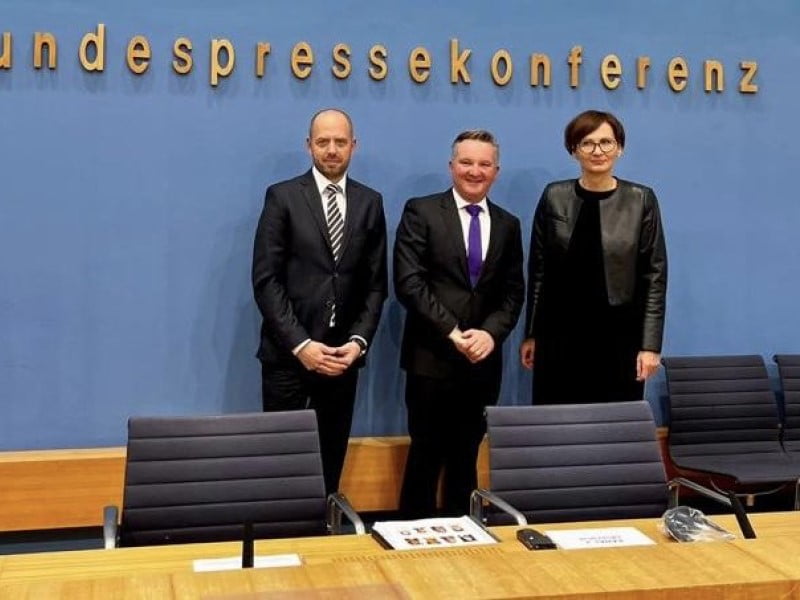A two-year Australian-German report has urged both governments to take “decisive early action” to enable green hydrogen exports at scale, noting that shipping hydrogen derivatives provides “an early path for international renewable hydrogen trade”.
The hydrogen supply chain feasibility project, HySupply, launched at the end of 2020 as a collaboration between Australian and German researchers.
A final report summarising the findings of eight key HySupply projects was released on Friday evening.
While the report argues that “there is much to be optimistic about” in the establishment of a renewable hydrogen supply chain between Australia and Germany, it notes that “time is of the essence” given the long timeline of infrastructure projects, limited technology supply chains, and competition from “faster moving jurisdictions” such as the United States.

The HySupply consortia considers shipping, production, and storage of ammonia and methanol produced from renewable hydrogen, the most “technically straightforward”. Shipping technology for these derivatives are mature, the derivatives have existing uses, and show promise for use as fuel, according to the report.
It also notes that “many in industry are growing frustrated with repetitive hydrogen feasibility projects that provide limited practical experience for overcoming the challenges and uncertainties in green hydrogen and would like to see prioritisation of scaled-up projects”.
“The viability of hydrogen and hydrogen derivative trade will require larger scale projects than currently being implemented. It seems likely that projects in the scale of 100-300 MW are required. This is an order of magnitude than the 10 MW projects now being implemented in Australia,” the report reads.
Government investment is also needed to de-risk early scaled-up projects, which should be made across a “range of possible hydrogen derivative pathways, rather than just backing a single exemplar project”. This approach will help reduce investment risk, “support a wider range of end-use applications and provide more lessons on our different options”, the report said.
On top of this, a “central coordinating platform” that brings together Australian and German government ministries, industry, and research associations should be established to “focus on target setting, tracking activities, assessing their progress, readjusting and setting up new activities as necessary”. A German-Australian hydrogen innovation hub is also proposed.
Climate Change and Energy minister Chris Bowen launched the HySupply report alongside German Minister for Education and Research Bettina Stark-Watzinger on Friday. They also announced the grant recipients under the HyGATE program.
“I’m very pleased to join you here today to launch both HyGATE and the Hysupply report, which confirms… for Germany and Australian citizens that not only is the export of green hydrogen from Australia to Germany feasible, it is highly desirable,” Mr Bowen said.
He told reporters that once hydrogen can be transported via ship, “it doesn’t matter whether you take it from Australia to New Zealand or Australia to Germany, cost is not that massive”.
“This is one of the great benefits of green hydrogen. Yes, as I said before, it’s hard to get up on the ship. But once you’ve cracked that technology and made that commercial, it can travel anywhere.”
Mr Bowen also said that the government is “dedicated to green hydrogen”. While he acknowledged that there are projects in the pipeline for blue hydrogen in Australia, Mr Bowen said the government is “focusing all our efforts on green hydrogen and I’m very confident that that will be the outcome”.
The Australian government’s Special Adviser for Low Emissions Technology Dr Alan Finkel has previously called for closer scrutiny of the claims made by critics of blue hydrogen.
German Minister for Education and Research Bettina Stark-Watzinger expressed the importance of developing the hydrogen supply chain to the bilateral relationship.
“I want to make Germany a hydrogen republic, and that’s why we want to accelerate the market ramp-up. We don’t have enough green hydrogen at the moment, and that’s why we have to be open in this market run,” Ms Stark-Watzinger said.
“As a strong industrialised country, we must of course continue to import energy, and Australia is the ideal partner for us. My goal is that the first delivery will actually arrive in Germany by 2030 at the latest.”
Australia and Germany signed a Hydrogen Accord in June 2021 to boost collaboration in activities that “focus on technological innovation, research, development and deployment and will lay the groundworks for a global hydrogen industry”.
The German Ministry of Education and Research’s Innovation Commissioner for Green Hydrogen Till Mansmann and his predecessor Dr Stefan Kaufmann have both stated that Germany will likely be dependent on energy exports, particularly from Australia, if it is to decarbonise its energy supply.
Australia’s current hydrogen investment pipeline, if fully developed, would make it the world’s largest exporter of green hydrogen.
The Office of Australia’s Chief Economist highlighted in a 2022 report that investment in hydrogen developments is the greatest across the resources and energy pipeline. It represents an estimated range of $230 billion to $303 billion of the total investment pipeline, estimated to be in the range $572 billion to $705 billion total.
However, more than half of the hydrogen investment pipeline is made up by two ”ambitious megaprojects” — the $100 billion Western Green Energy Hub and $50 billion Asian Renewable Energy Hub, both in Western Australia. A final investment decision on these projects is expected in 2027 and December 2024, respectively.
These projects propose to construct 50GW and 26GW of renewable generation capacity respectively.
Do you know more? Contact James Riley via Email.

